width PONTIAC FIERO 1988 Service User Guide
[x] Cancel search | Manufacturer: PONTIAC, Model Year: 1988, Model line: FIERO, Model: PONTIAC FIERO 1988Pages: 1825, PDF Size: 99.44 MB
Page 580 of 1825
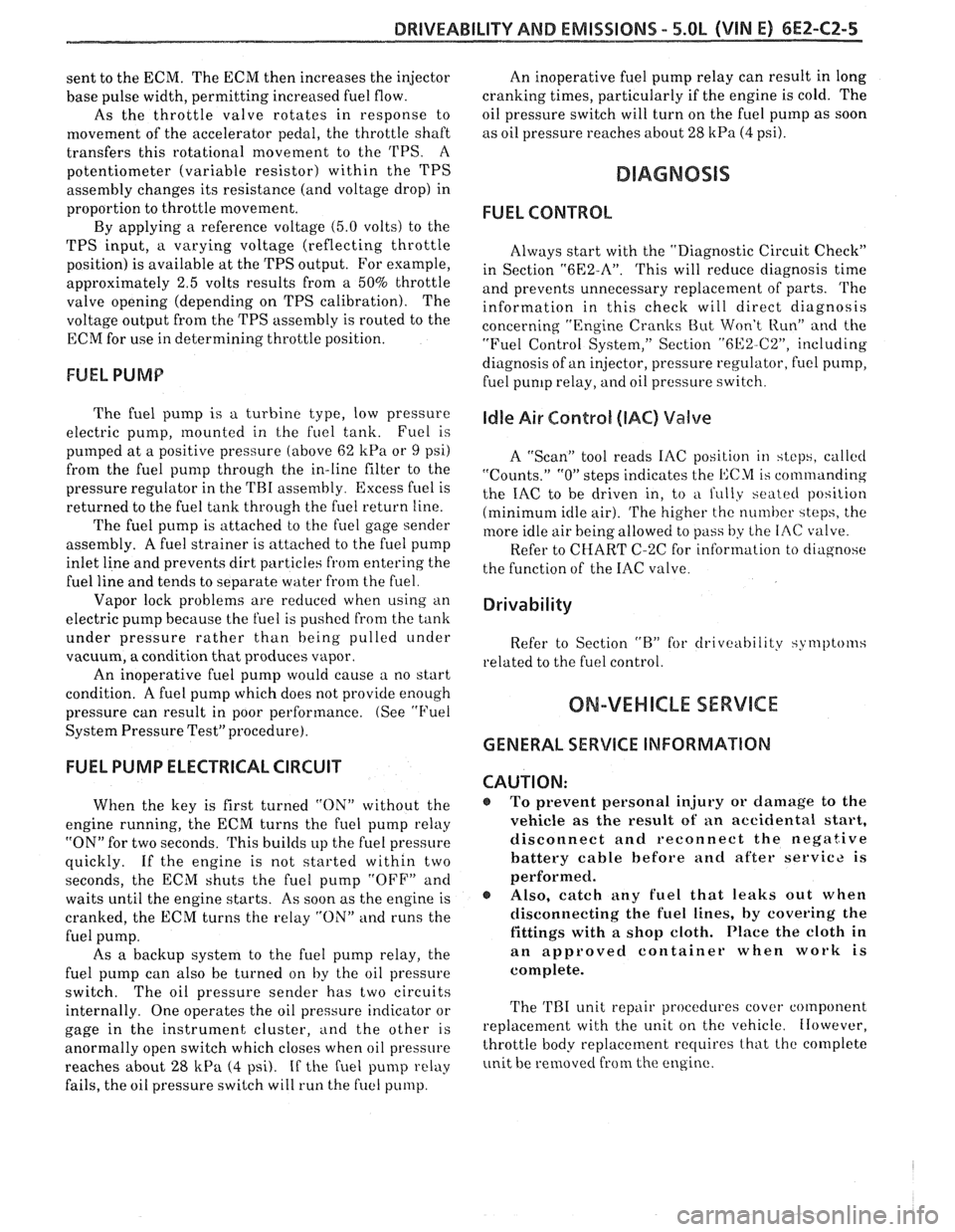
DRIVEABILITY AND EMISSIONS - 5.OL (\/IN El 6EZ-CZ-5
sent to the ECM. The ECM then increases the injector
base pulse width, permitting increased fuel flow.
As the throttle valve rotates in response to
movement of the accelerator pedal, the throttle shaft
transfers this rotational movement to the
'I'PS. A
potentiometer (variable resistor) within the TPS
assembly changes its resistance (and voltage drop) in
proportion to throttle movement.
By applying a reference voltage (5.0 volts) to the
TPS input, a varying voltage (reflecting throttle
position) is available at the TPS output. For example,
approximately 2.5 volts results from a 50% throttle
valve opening (depending on TPS calibration). The
voltage output from the TPS assembly is routed to the
ECM for use in determining throttle position.
FUEL PUMP
The fuel pump is a turbine type, low pressure
electric pump, mounted in the fuel tank. Fuel
is
pumped at a positive pressure (above 62
kPa or 9 psi)
from the fuel pump through the in-line filter to the
pressure regulator in the TBI assembly Excess
fuel is
returned to the fuel tank through the fuel return line.
The fuel pump is attached to the fuel gage sender
assembly. A fuel strainer is attached to the fuel pump
inlet line and prevents dirt particles from entering the
fuel line and tends to separate
water from the fuel
Vapor lock problems are reduced when using an
electric
pump because the fuel is pushed from the tank
under pressure rather than being pulled
under
vacuum, a condition that produces vapor.
An inoperative fuel pump would cause
a. no start
condition. A fuel pump which does not provide enough
pressure can result in poor performance. (See "Fuel
System Pressure Test" procedure).
FUEL PUMP ELECTRICAL CIRCUIT
When the key is first turned "ON" without the
engine running, the ECM turns the
Fuel pump relay
"ON" for two seconds. This builds
up the fuel pressure
quickly. If the engine is not started within two
seconds, the
ECM shuts the fuel pump "OFF" and
waits until the engine starts. As soon as the engine is
cranked, the ECM turns the relay
"ON" and runs the
fuel pump.
As a backup system to the fuel pump relay, the
fuel pump can also be turned on
by the oil pressure
switch. The oil pressure sender has two circuits
internally. One operates the oil pressure indicator or
gage in the instrument cluster,
itnd the other is
anormally open switch which closes when oil pressure
reaches about 28
kPa (4 psi). If the fuel pump relay
fails, the oil pressure switch will run the fuel pump. An
inoperative fuel pump relay can result in long
cranking times, particularly if the engine is cold. The
oil pressure switch will turn on the fuel pump as soon
as oil pressure
reaches about 28 kPa (4 psi).
FUEL CONTROL
Always start with the "Diagnostic Circuit Check"
in Section
"6E2-A". This will reduce diagnosis time
and prevents unnecessary replacement of parts. The
information in this check will direct diagnosis
concerning "Engine
Crunlis But Won't Run" and the
"Fuel Control System," Section
"6E2-C2", including
diagnosis of an injector, pressure regulator,
fuel pump,
fuel
pump relay, and oil pressure switch.
Idle Air Control (IAC) Valve
A "Scan" tool reads IAC position in steps, calletl
"Counts." "0" steps indicates the ECM is commanding
the
IAC to be driven in, to a fully seiltetl position
(minimum idle air).
The higher the number steps, the
more idle air being allowed to pass
by the IAC valve.
cnose Refer to CHART C-2C for information to cliil,
the function of the IAC valve.
Driva bility
Refer to Section "B" for driveability symptoms
related to the fuel control.
ON-VEHICLE SERVICE
GENERAL SEWVICE INFORMATION
CAUTION:
e To prevent personal injury or damage to the
vehicle
as the result sf an accidental start,
disconnect and reconnect the negative
battery cable before and after service is
performed.
@ Also, catch any fuel that leaks out when
disconnecting the fuel lines, by covering the
fittings with
a shop cloth. Place the cloth in
an approved container when work is
complete.
The 'FBI unit repair procedures cover component
replacement with the unit on the vehicle,
tIowever,
throttle body replacement requires that the complete
unit
be removed from the enginc.
Page 620 of 1825
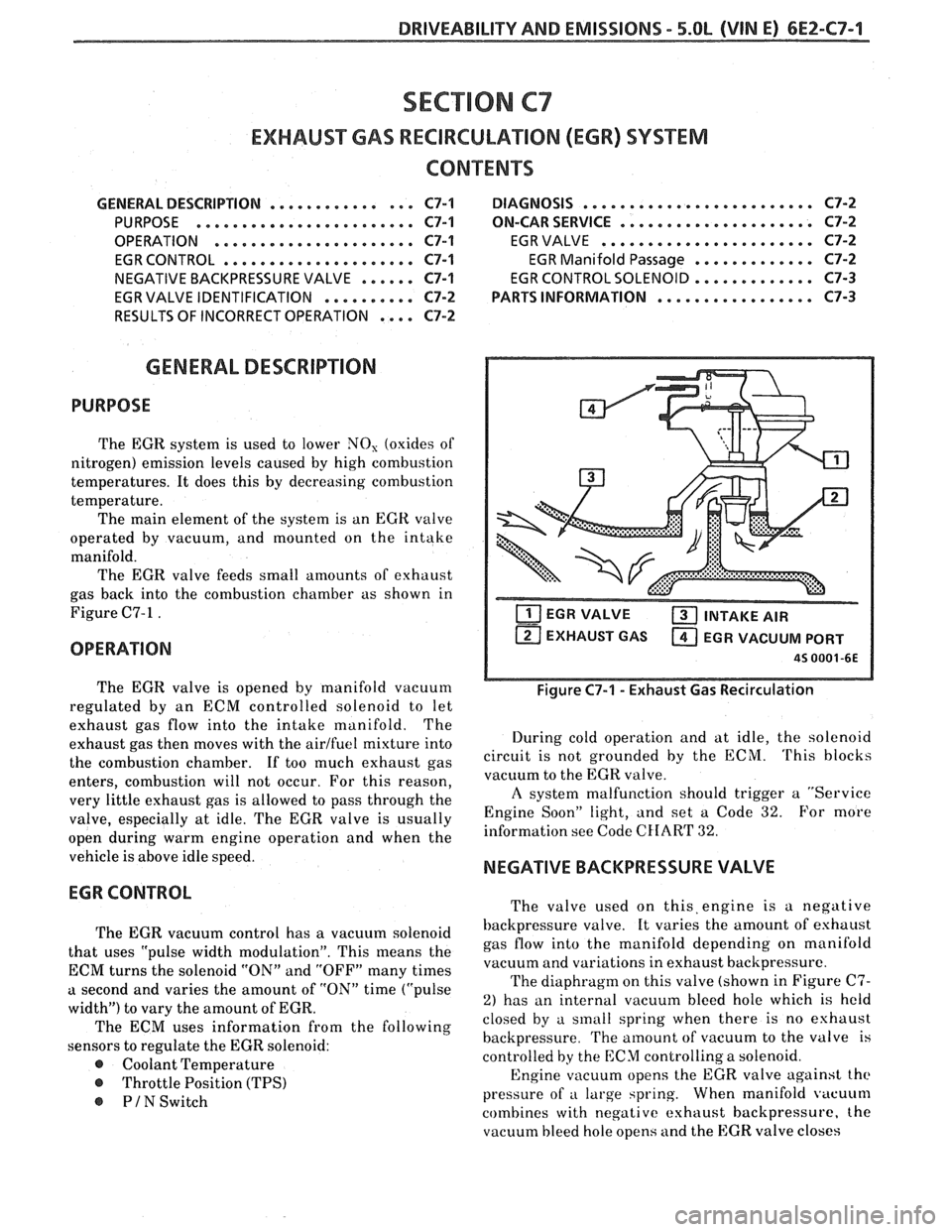
DRIVEABILITY AND EMISSIONS - 5.OL (VIN E) 6E2-C7-1
SECTION C7
EXHAUST GAS RECIRCULAVON (EGR) SYSEENO
GENERAL DESCRIPTION ...............
........................ PURPOSE
OPERATION
......................
EGR CONTROL .....................
...... NEGATIVE BACKPRESSURE VALVE
.......... EGR VALVE IDENTIFICATION
RESULTS OF INCORRECT OPERATION
. . , .
CONTENTS
......................... C7-1 DIAGNOSIS C7-2
..................... C7-1 ON-CAR SERVICE C7-2
....................... C7-1 EGRVALVE C7-2
............. C7-1 EGR Manifold Passage C7-2
C7-1
EGR CONTROL SOLENOID ............. C7-3
C7-2 PARTS INFORMATION
................. C7-3
C7-2
GENERAL DESCRIPTION
PURPOSE
The EGR system is used to lower NO, (oxides of
nitrogen) emission levels caused by high combustion
temperatures.
It does this by decreasing combustion
temperature. The main element of the system is an
EGR valve
operated by vacuum, and mounted on the intake
manifold. The EGR valve feeds small amounts of exhaust
gas back into the combustion chamber as shown in
Figure C7-1
.
OPERATION
The EGR valve is opened by manifold vacuum
regulated by an ECM controlled solenoid to let
exhaust gas flow into the intake manifold. The
exhaust gas then moves with the
airlfuel mixture into
the combustion chamber.
If too much exhaust gas
enters, combustion will not occur. For this reason,
very little exhaust gas is allowed to pass through the
valve, especially at idle. The EGR valve is usually
open during warm engine operation and when the
vehicle is above idle speed.
EGR CONTROL
The EGR vacuum control has a vacuum solenoid
that uses "pulse width modulation". This means the
ECM turns the solenoid "ON" and "OFF" many times
a second and varies the amount of "ON" time ("pulse
width") to vary the amount of EGR.
The ECM uses information from the following
sensors to regulate the EGR solenoid:
@ Coolant Temperature
@ Throttle Position (TPS)
PIN Switch
T'IT] EGR VALVE a INTAKE AIR
EXHAUST GAS
a EGR VACUUM PORT
45 0001 -6E
Figure C7-1 - Exhaust Gas Recirculation
During cold operation and at idle, the solenoid
circuit is not grounded by the ECM.
'I'his blocks
vacuum to the EGR valve.
A system malfunction should trigger a "Service
Engine Soon" light, and set a Code
32. For more
information see Code
CHAR'I' 32.
NEGATIVE BACKPRESSURE VALVE
The valve used on this,engine is a negative
backpressure valve. It varies the amount of eshaust
gas flow into the manifold depending on manifold
vacuum and variations in exhaust backpressure.
The diaphragm on this valve (shown in Figure
C7-
2) has an internal vacuum bleed hole which is held
closed by a sinall spring when there is no eshaust
backpressure.
The amount of vacuum to the valve is
controlled
by the ECM controlling a solenoid.
Engine vacuum opens the EGR valve against
the
pressure of a large spring. When manifold vacuum
combines with negative exhaust backpressure, the
vacuum bleed hole opens and the EGR valve closes
Page 661 of 1825
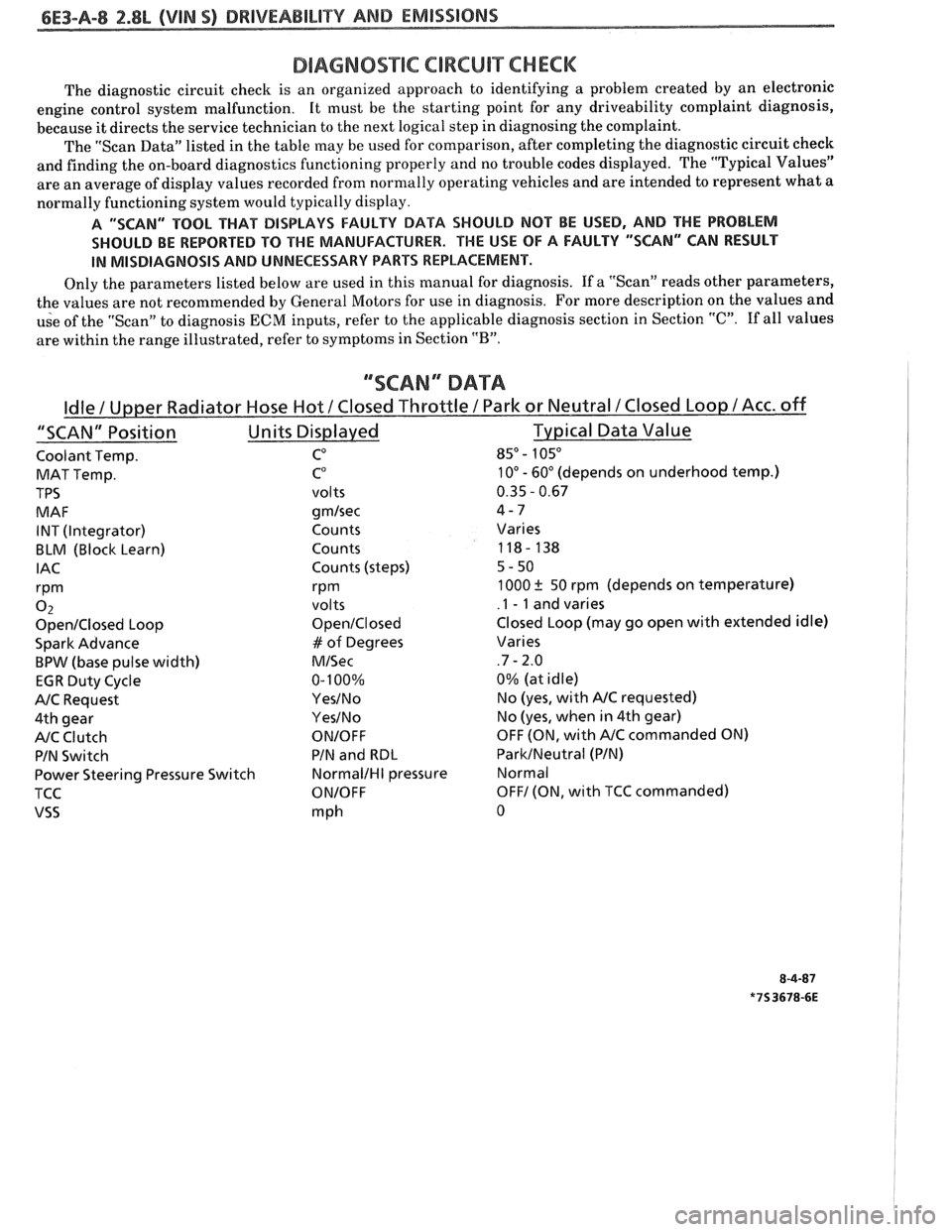
DIAGNOSTIC CIRCUIT CHECK
The diagnostic circuit check is an organized approach to identifying a problem created by an electronic
engine control system malfunction. It
must be the starting point for any driveability complaint diagnosis,
because it directs the service technician to the next logical step in diagnosing the complaint.
The "Scan Data" listed in the table may be used for comparison, after completing the diagnostic circuit check
and finding the on-board diagnostics functioning properly and no trouble codes displayed. The "Typical Values"
are an average of display values recorded from normally operating vehicles and are intended to represent what a
normally functioning system would typically display.
A "SCAN" TOOL THAT BiSPLAYS FAULTY DATA SHOULD NOT BE USED, AND THE PROBLEM
SHOULD BE REPORTED
TO THE MANUFACTURER. THE USE OF A FAULTY "SCAN" CAN RESULT
IN MISDIAGNOSIS AND UNNECESSARY PARTS REPLACEMENT.
Only the parameters listed below are used in this manual for diagnosis. If a "Scan" reads other parameters,
the values are not recommended by General Motors for use in diagnosis. For more description on the values and
use of the "Scan" to diagnosis
ECM inputs, refer to the applicable diagnosis section in Section "C". If all values
are within the range illustrated, refer to symptoms in Section
"B".
""SCAN" DATA
Coolant Temp. CO 85" - 105"
MAT Temp. C0 10" - 60" (depends on underhood temp.)
TPS
volts 0.35 - 0.67
MAF
gmlsec 4-7
INT (Integrator) Counts Varies
BLM (Block Learn) Counts 118- 138
IAC Counts (steps) 5-50
rPm rPm 1000 ? 50 rpm (depends on temperature)
0 2 volts .I - 1 and varies
OpenIClosed Loop OpenIClosed Closed Loop (may go open with extended idle)
Spark Advance
# of Degrees Varies
BPW (base pulse width) MISec .7 - 2.0
EGR Duty Cycle 0-
100% 0%
(at idle)
NC Request YesINo No (yes, with NC requested)
4th gear
YesINo No (yes, when in 4th gear)
NC Clutch ONIOFF OFF (ON, with NC commanded ON)
PIN Switch PIN
and
RBL ParkINeutral (PIN)
Power Steering Pressure Switch
NormalIHI pressure Normal
TCC
ONIOFF OFF1 (ON, with TCC commanded)
VSS mph 0
Page 740 of 1825
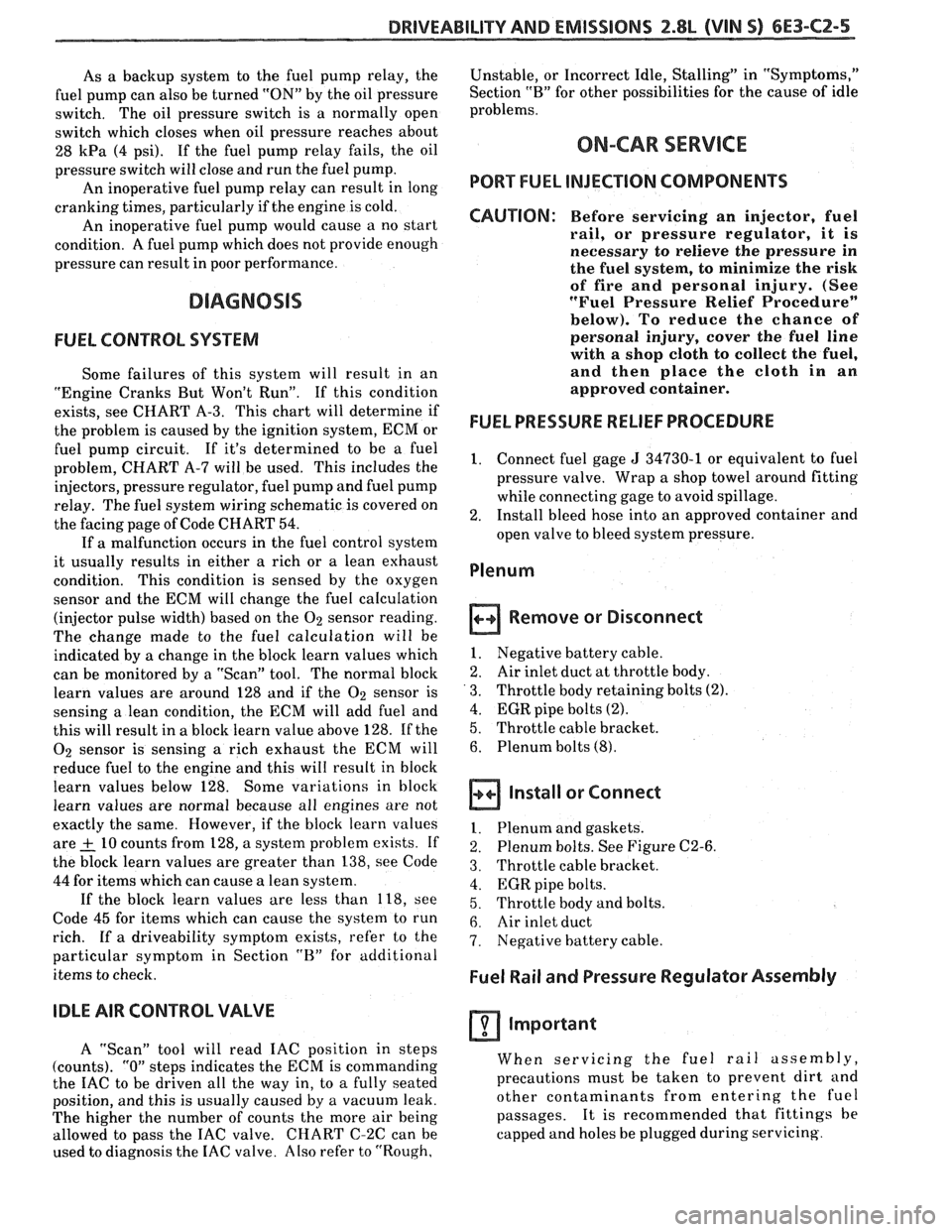
DRIVEABILITY AND EMISSIONS 2.8L (VIN 5) 6E3-C2-5
As a backup system to the fuel pump relay, the
fuel pump can also be turned "ON" by the oil pressure
switch. The oil pressure switch is a normally open
switch which closes when oil pressure reaches about
28
kPa (4 psi). If the fuel pump relay fails, the oil
pressure switch will close and run the fuel pump.
An inoperative fuel pump relay can result in long
cranking times, particularly if the engine is cold.
An inoperative fuel pump would cause a no start
condition. A fuel pump which does not provide enough
pressure can result in poor performance.
FUEL CONTROL SYSTEM
Some failures of this system will result in an
"Engine Cranks But Won't Run". If
this condition
exists, see CHART A-3. This chart will determine if
the problem is caused by the ignition system, ECM or
fuel pump circuit. If
it's determined to be a fuel
problem, CHART
A-7 will be used. This includes the
injectors, pressure regulator, fuel pump and fuel pump
relay. The fuel system wiring schematic is covered on
the facing page of Code CHART
54.
If a malfunction occurs in the fuel control system
it usually results in either a rich or a lean exhaust
condition. This condition is sensed by the oxygen
sensor and the ECM will change the fuel calculation
(injector pulse width) based on the
02 sensor reading.
The change made to the fuel calculation will be
indicated by a change in the block learn values which
can be monitored by a "Scan" tool. The normal block
learn values are around 128 and if the
O2 sensor is
sensing a lean condition, the ECM will add fuel and
this will result in a block learn value above 128. If the
02 sensor is sensing a rich exhaust the ECM will
reduce fuel to the engine and this will result in block
learn values below 128. Some variations in block
learn values are normal because all engines are not
exactly the same. However, if the block learn values
are
+ 10 counts from 128, a system problem exists. If
the block learn values are greater than 138, see Code
44 for items which can cause a lean system.
If the block learn values are less than 118, see
Code
45 for items which can cause the system to run
rich. If a driveability symptom exists, refer to the
particular symptom in Section
"B" for additional
items to check.
IDLE AIR CONTROL VALVE
A "Scan" tool will read IAC position in steps
(counts).
"0" steps indicates the ECM is commanding
the IAC to be driven all the way in, to a fully seated
position, and this is usually caused by a vacuum leak.
The higher the number of counts the more air being
allowed to pass the IAC valve. CHART C-2C can be
used to diagnosis the IAC valve. Also refer to "Rough, Unstable,
or Incorrect Idle, Stalling" in "Symptoms,"
Section
"B" for other possibilities for the cause of idle
problems.
ON-CAR SERVICE
PORT FUEL INJECTION COMPONENTS
CAUTION:
Before servicing an injector, fuel
rail, or pressure regulator, it is
necessary to relieve the pressure in
the fuel system, to minimize the risk
of fire and personal injury. (See
"Fuel Pressure Relief Procedure"
below). To reduce the chance of
personal injury, cover the fuel line
with a shop cloth to collect the fuel,
and then place the cloth in an
approved container.
FUEL PRESSURE RELIEF PROCEDURE
Connect fuel gage J 34730-1 or equivalent to fuel
pressure valve. Wrap a shop towel around fitting
while connecting gage to avoid spillage.
Install bleed hose into an approved container and
open valve to bleed system pressure.
Plenum
Remove or Disconnect
1. Negative battery cable.
2. Air
inlet duct at throttle body.
3. Throttle body retaining bolts
(2).
4. EGR pipe bolts (2).
5. Throttle cable bracket.
6. Plenum bolts (8).
Install or Connect
I. Plenum and gaskets.
2. Plenum bolts. See Figure C2-6.
3. Throttle cable bracket.
4. EGR pipe bolts.
5. Throttle body and bolts.
6. Air inlet duct
7. Negative battery cable.
Fuel Rail and Pressure Regulator Assembly
Important
When servicing the fuel rail assembly,
precautions must be taken to prevent dirt and
other contaminants from entering the fuel
passages. It is recommended that fittings
he
capped and holes be plugged during servicing.
Page 778 of 1825
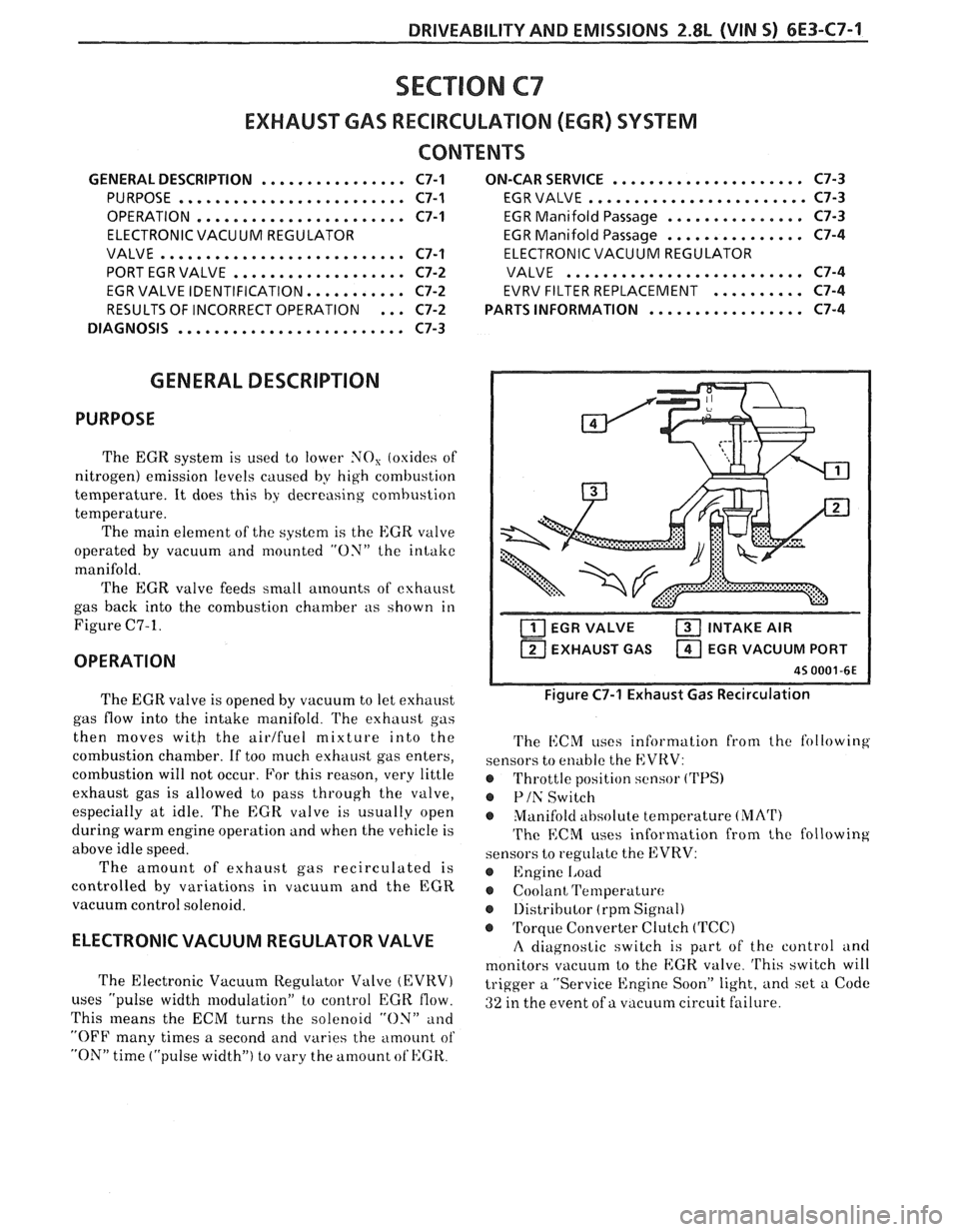
DRIVEABILITY AND EMISSIONS 2.8L (VIN 5) 6E3-C7-1
SECTION C7
EXHAUST GAS RECIRCULATION (EGR) SYSTEM
CONTENTS
GENERAL DESCRIPTION ................ C7-1
PURPOSE
......................... C7-1
OPERATION
....................... C7-1
ELECTRONIC VACUUM REGULATOR
VALVE
........................... C7-1
PORT EGR VALVE
................... C7-2
EGR VALVE IDENTIFICATION..
......... C7-2
RESULTS OF INCORRECT OPERATION
... C7-2
DIAGNOSIS
......................... C7-3
GENERAL DESCRIPTION
PURPOSE
The EGR system is used to lower NO, (oxides of
nitrogen) emission levels caused by high combustion
temperature. It does this
by decreasing combustion
temperature.
The main element of the system is the
EGR valve
operated by vacuum and mounted
"ON" the intake
manifold.
The EGR valve feeds small
amounts of exhaust
gas back into the combustion chamber as shown in
Figure C7-1.
OPERATION
..................... ON-CAR SERVICE C7-3
EGR VALVE
........................ C7-3
EGR Manifold Passage
............... C7-3
EGR Manifold Passage
............... C7-4
ELECTRONIC VACUUM REGULATOR
VALVE
.......................... C7-4
EVRV FILTER REPLACEMENT
.......... C7-4
................. PARTS INFORMATION C7-4
EGR VALVE INTAKE AIR
1 EXHAUST GAS EGR VACUUM PORT I
The EGR valve is opened by vacuum to let exhaust
gas flow into the intake manifold.
l'he exhaust gas
then moves
witb the airlfuel mixture into the
combustion chamber. If too much exhaust gas enters,
combustion will not occur. For this reason, very little
exhaust gas is allowed to pass through the valve,
especially at idle. The
EGR valve is usually open
during warm engine operation and when the vehicle is
above idle speed.
The amount of exhaust gas recirculated is
controlled by variations in vacuum and the EGR
vacuum control solenoid.
ELECTRONIC VACUUM REGULATOR VALVE
The Electronic Vacuum Regulator Valve (EVRV)
uses "pulse width modulation" to control EGK flow.
This
means the ECM turns the solenoid "ON" and
"OFF many times a second and varies the amount of
"ON" time ("pulse width") to vary the amount ot'HGK.
Figure C7-1 Exhaust Gas Recirculation
The i1:CM uses information from the following
sensors to enable the EVRV:
@ Throttle position sensor ('I'PS)
@ Plh' Switch
Manifold
ahsolute temperature (MArI')
The ECM uses information from the following
sensors to regulate the EVRV:
@ Engine 1,oad
Coolant Temperature
@ 1)istributor (rpm Signal)
@ Torque Converter Clutch (TCC)
A diagnostic switch is part of the control and
monitors vacuum to the
EGK. valve. 'I'his switch will
trigger a "Service Engine Soon" light, and set a Code
ai ure. 32 in the event of a vacuum circuit f 'I
Page 811 of 1825
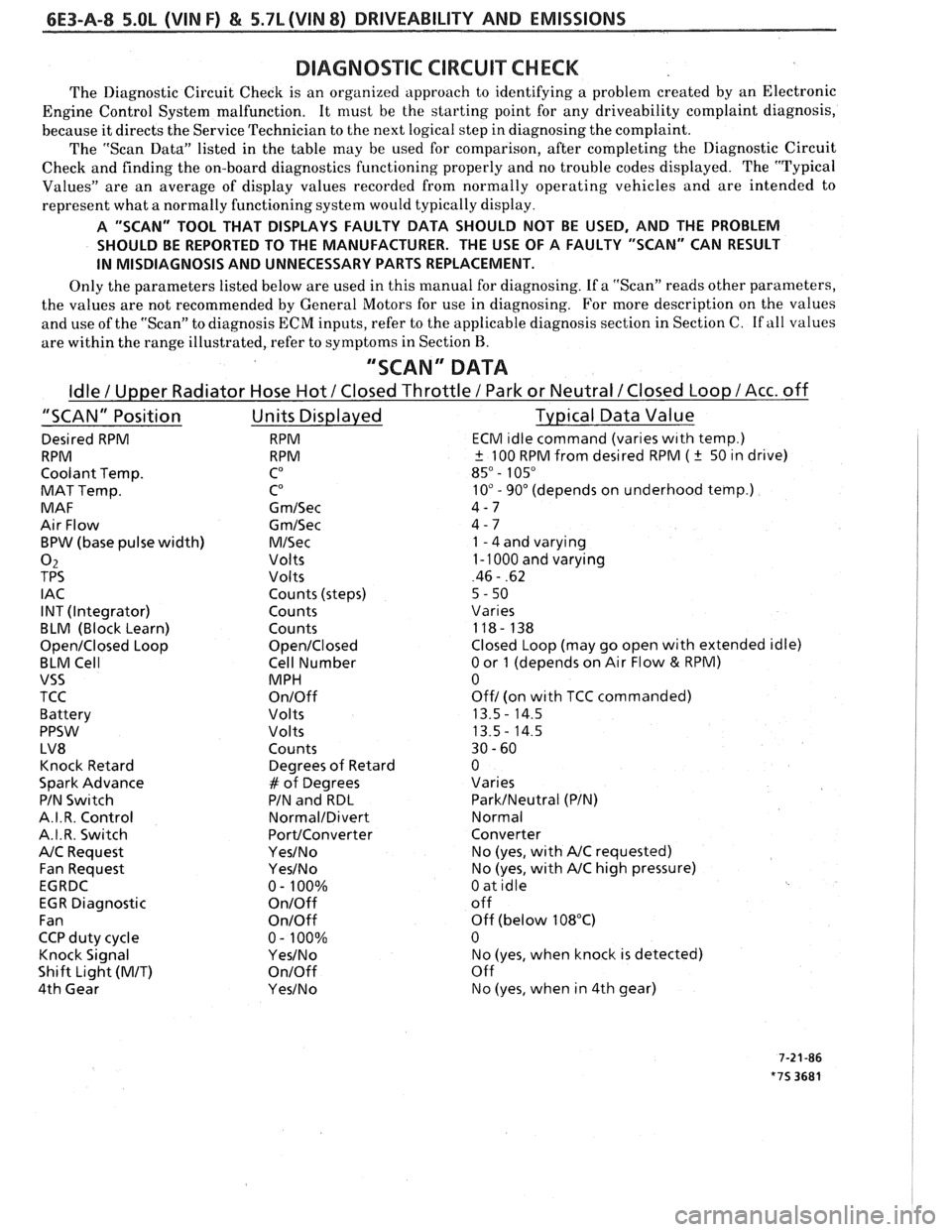
6E3-A-8 5.OL (VIN F) & 5.7L(VIN 8) DRIVEABILITY AND EMISSIONS
DIAGNOSIC CIRCUIXCHECK
The Diagnostic Circuit Checlc is an organized approach to identifying a problem created by an Electronic
Engine Control System malfunction. It
must be the starting point for any driveability complaint diagnosis,
because it directs the Service Technician to the next logical step in diagnosing the complaint.
The "Scan Data" listed in the table may be used for comparison, after completing the Diagnostic Circuit
Check and finding the on-board diagnostics functioning properly and no trouble codes displayed. The "Typical
Values" are an average of display values recorded from normally operating vehicles and are intended to
represent what a normally functioning system would typically display.
A "SCAN" TOOL THAT DISPLAYS FAULTY DATA SHOULD NOT BE USED, AND THE PROBLEM
SHOULD BE REPORTED TO THE MANUFACTURER. THE USE OF A FAULTY "SCAN" CAN RESULT
IN MISDIAGNOSIS AND UNNECESSARY PARTS REPLACEMENT.
Only the parameters listed below are used in this manual for diagnosing. If a "Scan" reads other parameters,
the values are not recommended by General Motors for use in diagnosing. For more description on the values
and use of the "Scan" to diagnosis ECM inputs, refer to the applicable diagnosis section in Section C.
If all values
are within the range illustrated, refer to symptoms in Section
B.
"SCAN" DATA
Idle / Upper Radiator Hose Hot / Closed Throttle / Park or Neutral /Closed Loop /Acc. off
"SCAN" Position Units Displayed Typical Data Value
Desired RPM RPM ECM ~dle command (vanes w~th temp.)
RPM RPM
+ 100 RPM from desired RPM ( k 50 ~n drive)
Coolant Temp.
CO 85" - 105"
MAT Temp. CO 10" - 90" (depends on underhood temp.)
MAF G
m/Sec 4-7
Air Flow
Gm/Sec 4 - 7
BPW (base pulse width)
M/Sec 1 - 4 and varying
02 Volts 1 - 1000 and varying
TPS Volts 46 - .62
I AC Counts (steps)
5 - 50
INT (Integrator) Counts
Vanes
BLM (Block Learn) Counts 118- 138
Open/Closed Loop Open/Closed Closed Loop (may go open with extended idle)
BLM Cell Cell Number
0 or 1 (depends on Air Flow & RPM)
VSS MPH 0
TCC
On/Off Off/ (on wlth TCC commanded)
Battery Volts 13.5
- 14.5
PPSW
Volts 13.5- 14.5
LV8 Counts 30
- 60
Knock Retard Degrees
of Retard 0
Spark Advance
# of Degrees Varies
PIN
Swltch PIN and RDL ParkINeutral (PIN)
A.I. R. Control
Normal/Divert Normal
A.I.R. Switch
PortIConverter Converter
NC Request Yes/No No (yes, wlth NC requested)
Fan Request
Yes/No No (yes, with NC high pressure)
EGRDC 0- 100%
0 at idle
EGR Diagnostic
On/Off off
Fan
OnIOff Off (below 108°C)
CCP duty cycle 0
- 100% 0
Knock Signal
YesINo No (yes, when knock is detected)
Shift Light
(MIT) On/Off Off
4th Gear
Yes/No No (yes, when in 4th gear)
Page 892 of 1825
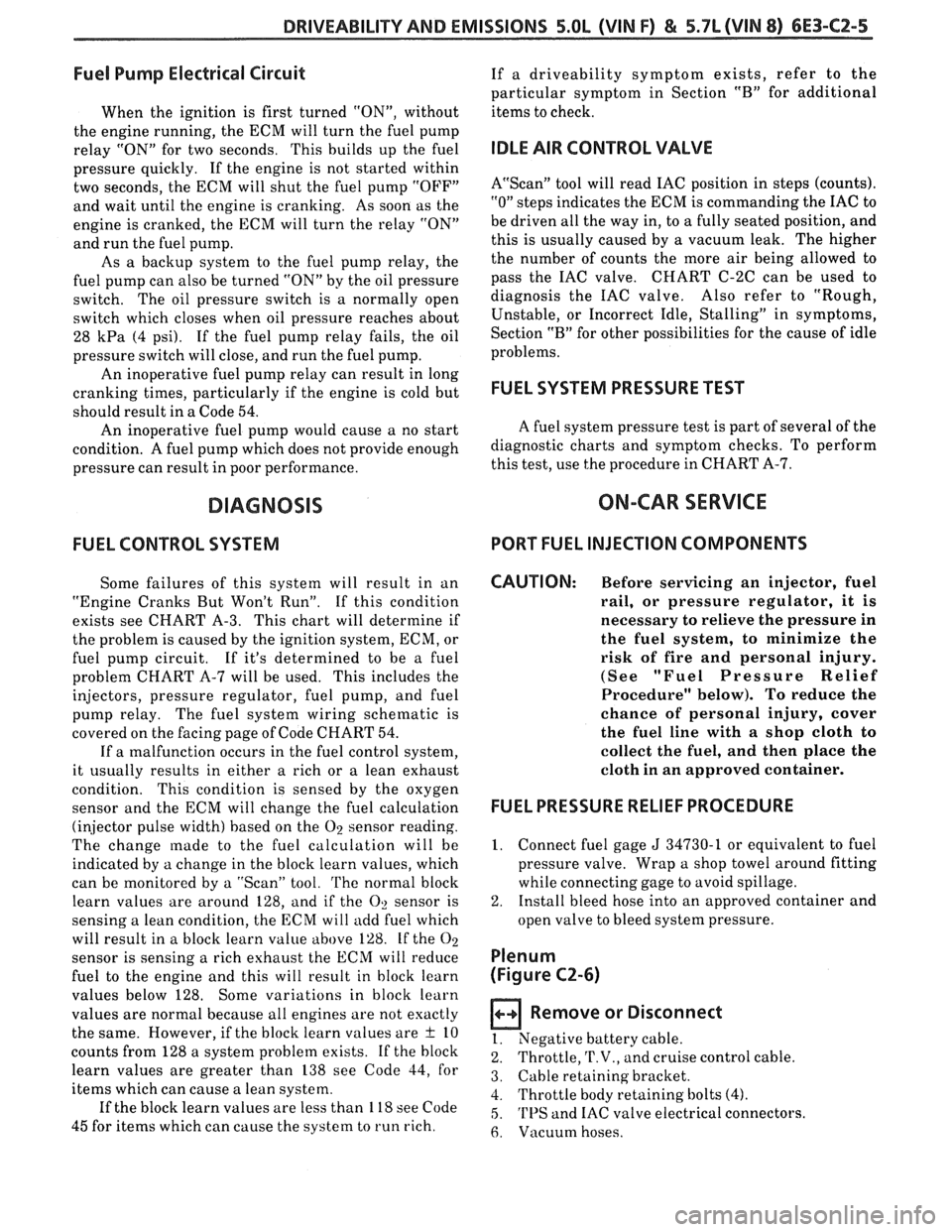
DRIVEABILITY AND EMISSIONS 5.OL (VIN F) & 5.7L (VIN 8) 6E3-C2-5
Fuel Pump Electrical Circuit
When the ignition is first turned "ON", without
the engine running, the ECM will turn the fuel pump
relay "ON" for two seconds.
This builds up the fuel
pressure quickly. If the engine is not started within
two seconds, the ECM will shut the fuel pump "OFF"
and wait until the engine is cranking. As soon as the
engine is cranked, the ECM will turn the relay "ON"
and run the fuel pump.
As
a backup system to the fuel pump relay, the
fuel pump can also be turned "ON" by the oil pressure
switch. The oil pressure switch is a normally open
switch which closes when oil pressure reaches about
28
kPa (4 psi). If the fuel pump relay fails, the oil
pressure switch will close, and run the fuel pump.
An inoperative fuel pump relay can result in long
cranking times, particularly if the engine is cold but
should result in
a Code 54.
An inoperative fuel pump would cause a no start
condition. A fuel pump which does not provide enough
pressure can result in poor performance.
DIAGNOSIS
FUEL CONTROL SYSTEM
Some failures of this system will result in an
"Engine Cranks But Won't Run". If
this condition
exists see CHART A-3. This chart will determine if
the problem is caused by the ignition system, ECM, or
fuel pump circuit. If
it's determined to be a fuel
problem CHART A-7 will be used. This includes the
injectors, pressure regulator, fuel pump, and fuel
pump relay. The fuel system wiring schematic is
covered on the facing page of Code CHART 54.
If a malfunction occurs in the fuel control system,
it usually results in either a rich or
a lean exhaust
condition. This condition is sensed by the oxygen
sensor and the ECM will change the fuel calculation
(injector pulse width) based on the
O2 sensor reading.
The change
made to the fuel calculation will be
indicated by a change in the block learn values, which
can be monitored by a "Scan" tool.
The normal block
learn values are around 128, and if the
O2 sensor is
sensing a lean condition, the EC
M will add fuel which
will result in a block learn value above 128.
If the O2
sensor is sensing a rich exhaust the ECM will reduce
fuel to the engine and this will result in block learn
values below 128. Some variations in block
learn
values are normal because all engines are not exactly
the same. However, if the block learn values are
+ 10
counts from 128 a system problem exists. If the block
learn values are greater than 138 see Code 44, for
items which can cause a lean system.
If the block learn values are less than 118 see Code
45 for items which can cause the system to run rich. If
a driveability symptom exists, refer to the
particular symptom in Section
"B" for additional
items to check.
IDLE AIR CONTROL VALVE
AUScan" tool will read IAC position in steps (counts).
"0" steps indicates the ECM is commanding the IAC to
be driven all the way in, to a fully seated position, and
this is usually caused by a vacuum leak. The higher
the number of counts the more air being allowed to
pass the IAC valve. CHART C-2C can be used to
diagnosis the IAC valve. Also refer to "Rough,
Unstable, or Incorrect Idle, Stalling" in symptoms,
Section "B" for other possibilities for the cause
of idle
problems.
FUEL SYSTEM PRESSURE TEST
A fuel system pressure test is part of several of the
diagnostic charts and symptom checks. To perform
this test, use the procedure in CHART A-7.
ON-CAR SERVICE
PORT FUEL INJECTION COMPONENTS
CAUTION:
Before servicing an injector, fuel
rail, or pressure regulator,
it is
necessary to relieve the pressure in
the fuel system, to minimize the
risk of fire and personal injury.
(See "Fuel Pressure Relief
Procedure" below). To reduce the
chance of personal injury, cover
the fuel line with
a shop cloth to
collect the fuel, and then place the
cloth in an approved container.
FUEL PRESSURE RELIEF PROCEDURE
1. Connect fuel gage J 34730-1 or equivalent to fuel
pressure valve. Wrap a shop towel around fitting
while connecting gage to avoid spillage.
2. Install bleed hose into an approved container and
open valve to bleed system pressure.
Plenum
(Figure
C2-6)
Remove or Disconnect
1. Negative battery cable.
2. Throttle, 'F.V., and cruise control cable.
3. Cable retaining bracket.
4.
'I'hrottle body retaining bolts (4).
5. 'L'l'S and IAC valve electrical connectors.
6. Vacuum hoses.
Page 936 of 1825
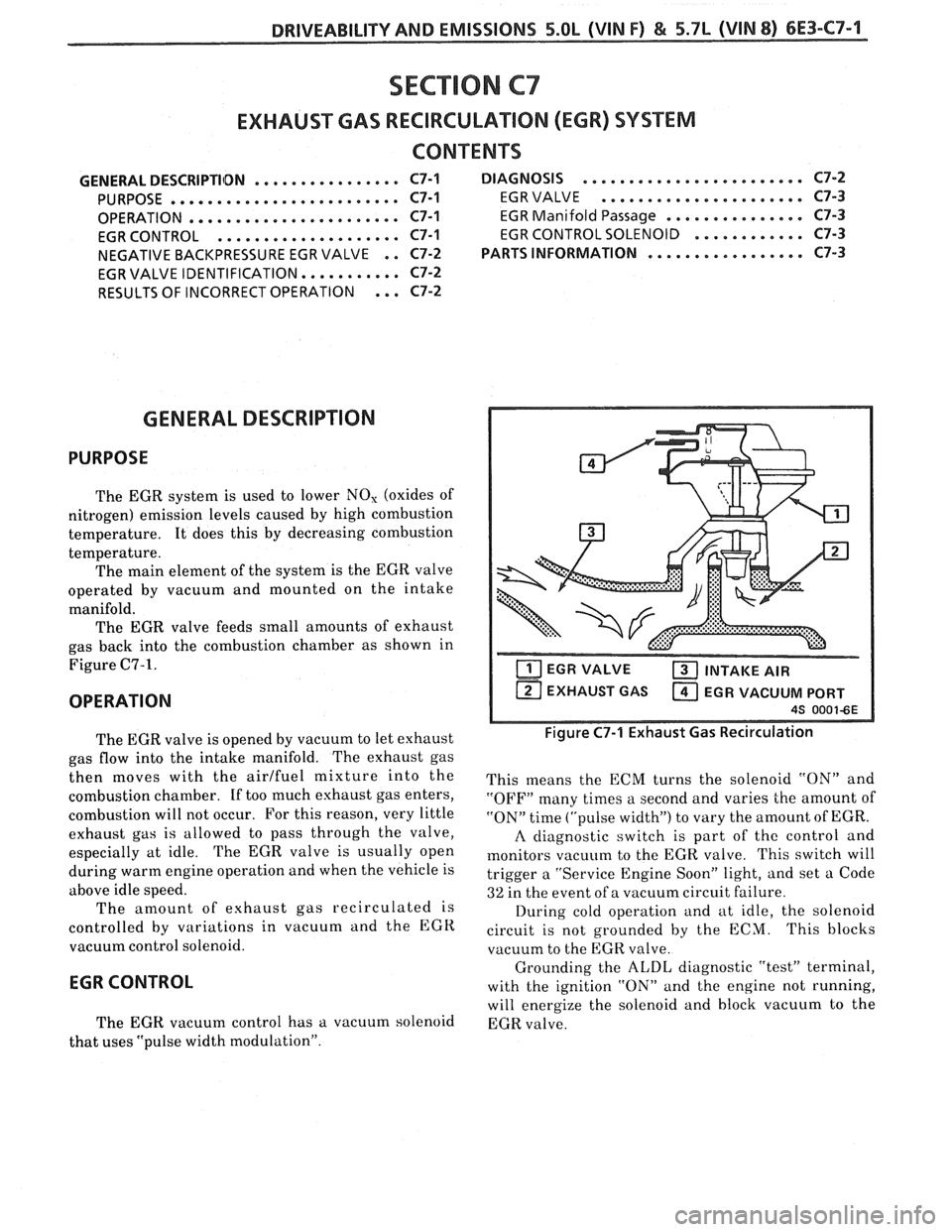
DRIVEABILITY AND EMISSIONS 5.0L (VIN F) €4 5.7L (VIN 8) 6E3-C7-1
SECTION C7
EXHAUST GAS REClRCULATlON (EGR) SYSTEM
CONTENTS
................ GENERAL DESCRIPTIlDN C7-1 DIAGNOSIS ........................ C7-2
PURPOSE
......................... C7-1 EGR VALVE ...................... C7-3
....................... OPERATION C7-1 EGR Manifold Passage ............... C7-3
.................... EGR CONTROL C7-1
EGR CONTROL SOLENOID ............ C7-3
NEGATIVE BACKPRESSURE EGR VALVE
. . C7-2 PARTS INFORMATION ................. C7-3
......... EGR VALVE IDENTIFICATION.. C7-2
... RESULTS OF INCORRECT OPERATION C7-2
GENERAL DESCRIPTION
PURPOSE
The EGR system is used to lower NO, (oxides of
nitrogen) emission levels caused by high combustion
temperature. It does this by decreasing combustion
temperature. The main element of the system is the EGR valve
operated by vacuum and mounted on the intake
manifold.
The EGR valve feeds small amounts of exhaust
gas back into the combustion chamber as shown in
Figure
C7-1.
OPERATION
The EGR valve is opened by vacuum to let exhaust
gas flow into the intake manifold. The exhaust gas
then moves with the
airlfuel mixture into the
combustion chamber.
If too much exhaust gas enters,
combustion will not occur. For this reason, very little
exhaust gas is allowed to pass through the valve,
especially at idle. The EGR valve is usually open
during warm engine operation and when the vehicle is
above idle speed. The amount of exhaust gas recirculated is
controlled by variations in vacuum and the
EGR
vacuum control solenoid.
EGR CONTROL
The EGR vacuum control has a vacuum solenoid
that uses "pulse width modulation".
EGR VALVE INTAKE AIR
EXHAUST GAS EGR VACUUM PORT
Figure C7-1 Exhaust Gas Recirculation
This means the ECM turns the solenoid "ON" and
"OFF" many times a second and varies the amount of
"ON" time ("pulse width") to vary the amount of EGR.
A diagnostic switch is part of the control and
monitors vacuum to the EGR valve. This switch will
trigger a "Service Engine Soon" light, and set a Code
32 in the event of a vacuum circuit failure.
During cold operation and at idle, the solenoid
circuit is not grounded by the ECM. This blocks
vacuum to the EGR valve.
Grounding the
ALDL diagnostic "test" terminal,
with the ignition "ON" and the engine not running,
will energize the solenoid and block vacuum to the
EGR valve.
Page 939 of 1825
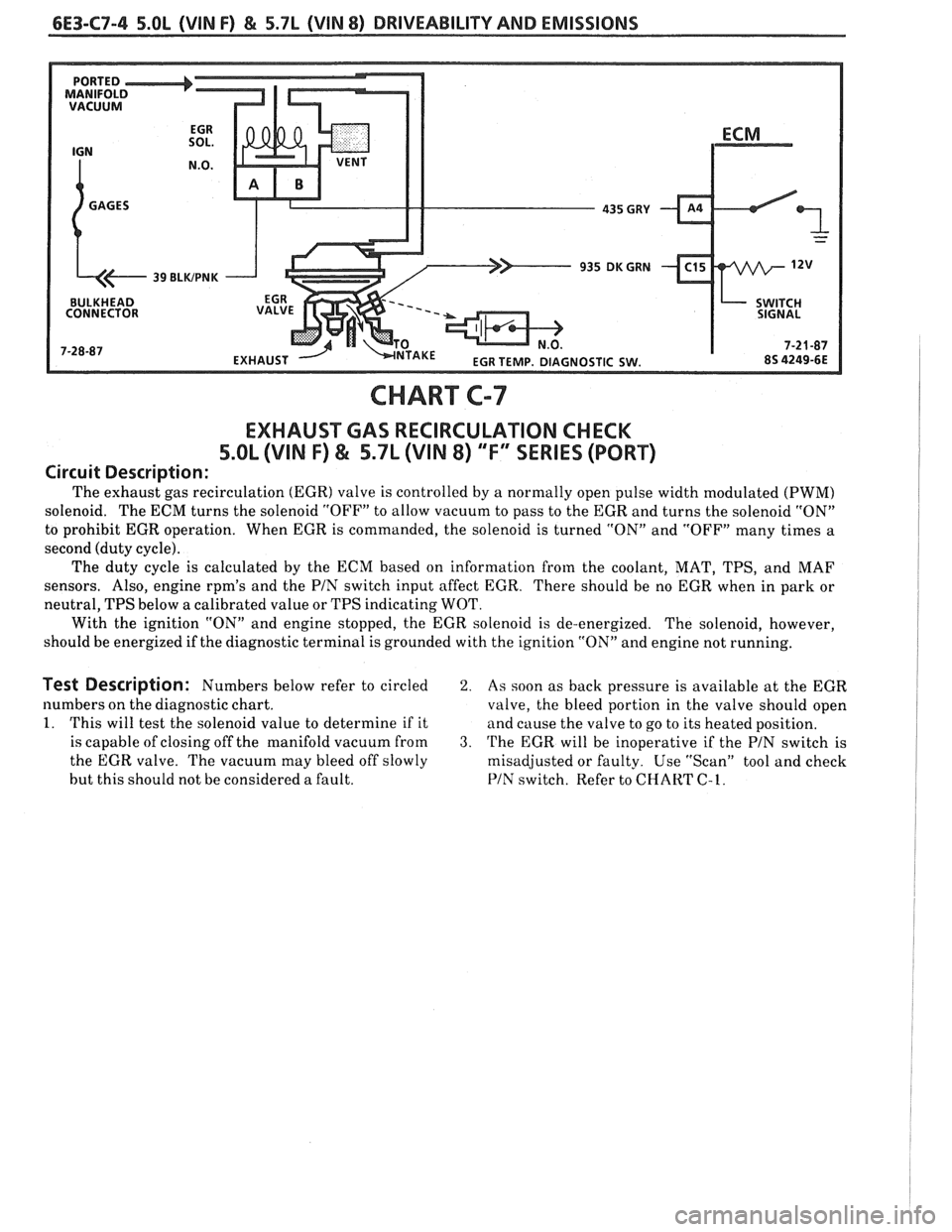
6E3-C7-4 5.OL (VIN F) €4 5.7L (VIN 8) DRIVEABILITY AND EMISSIONS
CHART C-7
EXHAUST GAS RECIRCULATION CHECK
5.OL (VIN F) & 5.7L (VIN 8) "F" SERIES (PORT)
Circuit Description:
The exhaust gas recirculation (EGR) valve is controlled by a normally open pulse width modulated (PWM)
solenoid. The ECM turns the solenoid "OFF" to allow vacuum to pass to the EGR and turns the solenoid "ON"
to prohibit EGR operation. When EGR is commanded, the solenoid is turned "ON" and "OFF" many times a
second (duty cycle).
The duty cycle is calculated by the ECM based on information from the coolant, MAT, TPS, and MAF
sensors. Also, engine
rpm's and the PIN switch input affect EGR.
There should be no EGR when in park or
neutral, TPS below
a calibrated value or TPS indicating WOT.
With the ignition "ON" and engine stopped, the EGR solenoid is de-energized. The solenoid, however,
should be energized if the diagnostic terminal is grounded with the ignition "ON" and engine not running.
Test Description: Numbers below refer to circled 2. As soon as back pressure is available at the EGR
numbers on the diagnostic chart.
valve, the bleed portion in the valve should open
1. This will test the solenoid value to determine if it
and cause the valve to go to its heated position.
is capable of closing off the manifold vacuum from
3. 'I'he EGR will be inoperative if the PIN switch is
the EGR valve. The vacuum may bleed off slowly
misadjusted or faulty. Use "Scan" tool and check
but this should not be considered a fault.
PIN switch. Refer to CHART C-1.
Page 968 of 1825
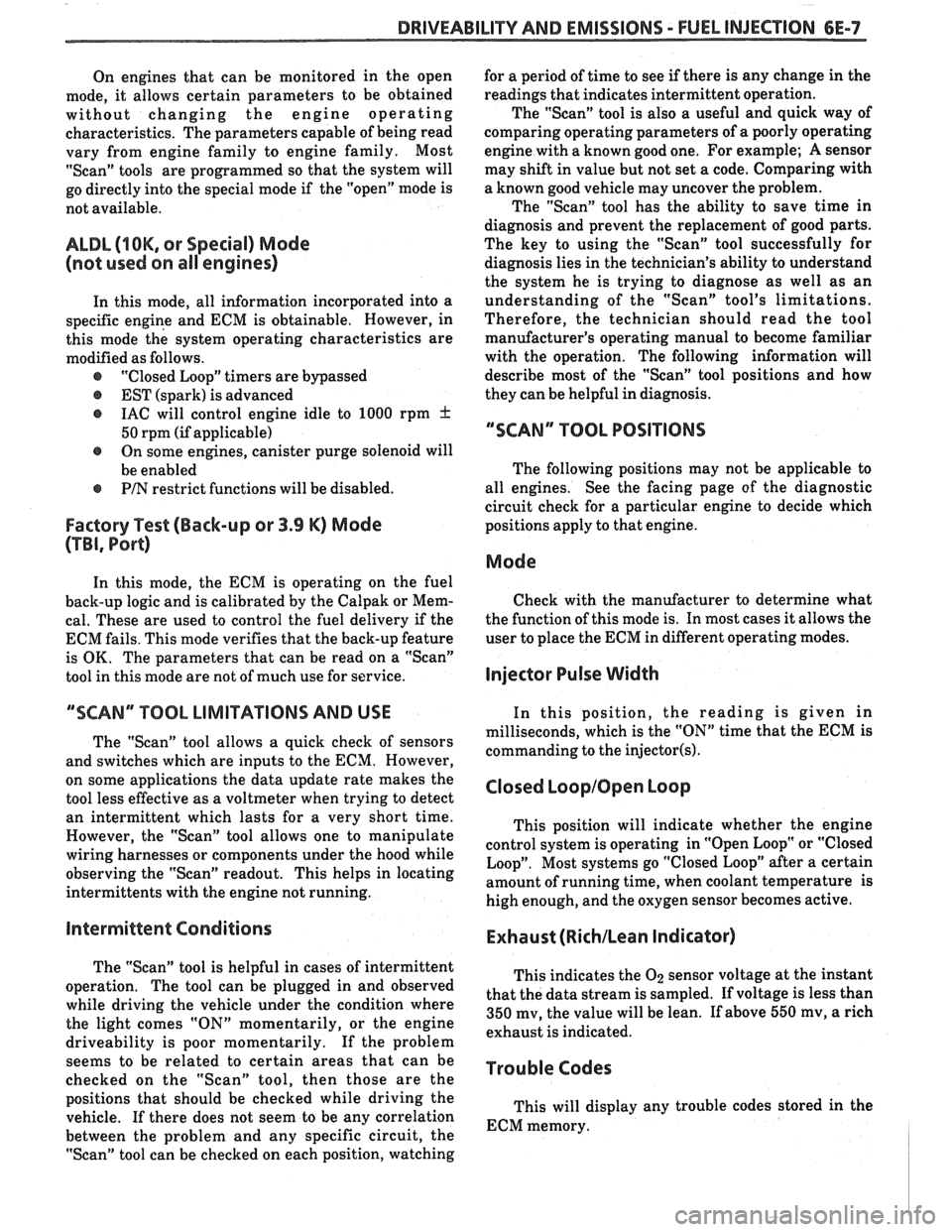
DRIVEABILITY AND EMISSIONS - FUEL INJECTION 6E-7
On engines that can be monitored in the open
mode, it allows certain parameters to be obtained
without changing the engine operating
characteristics. The parameters capable of being read
vary from engine family to engine family. Most
"Scan" tools are programmed so that the system will
go directly into the special mode
if the "open" mode is
not available.
ALDL (7 OK, or Special) Mode
(not used on
all engines)
In this mode, all information incorporated into a
specific
engine and ECM is obtainable. However, in
this mode the system operating characteristics are
modified as follows.
@ "Closed Loop" timers are bypassed
EST (spark) is advanced
@ IAC will control engine idle to 1000 rpm I
50 rpm (if applicable)
@ On some engines, canister purge solenoid will
be enabled
@ P/N restrict functions will be disabled.
Factory Test (Back-up or 3.9 K) Mode
(TBI, Port)
In this mode, the ECM is operating on the fuel
back-up logic and is calibrated by the Calpak or Mem-
cal. These are used to control the fuel delivery
if the
ECM fails. This mode verifies that the back-up feature
is OK. The parameters that can be read on a
"Scan"
tool in this mode are not of much use for service.
"SCAN" TOOL LIMITATIONS AND USE
The "Scan" tool allows a quick check of sensors
and switches which are inputs to the ECM. However,
on some applications the data update rate makes the
tool less effective as a voltmeter when trying to detect
an intermittent which lasts for a very short time.
However, the "Scan" tool allows one to manipulate
wiring harnesses or components under the hood while
observing the "Scan" readout. This helps in locating
intermittents with the engine not running.
intermittent Conditions
for a period of time to see if there is any change in the
readings that indicates intermittent operation.
The "Scan" tool is also a useful and quick way of
comparing operating parameters of a poorly operating
engine with a known good one. For example;
A sensor
may shift in value but not set a code. Comparing with
a known good vehicle may uncover the problem.
The "Scan" tool has the ability to save time in
diagnosis and prevent the replacement of good parts.
The key to using the "Scan" tool successfully for
diagnosis lies in the technician's ability to understand
the system he is trying to diagnose as well as an
understanding of the "Scan" tool's limitations.
Therefore, the technician should read the tool
manufacturer's operating manual to become familiar
with the operation. The following information will
describe most of the "Scan" tool positions and how
they can be helpful in diagnosis.
"SCAN" TOOL POSITIONS
The following positions may not be applicable to
all engines. See the facing page
of the diagnostic
circuit check for a particular engine to decide which
positions apply to that engine.
Mode
Check with the manufacturer to determine what
the function of this mode is. In most cases it allows the
user to place the ECM in different operating modes.
Injector Pulse Width
In this position, the reading is given in
milliseconds, which is the
"ON" time that the ECM is
commanding to the
injector(s1.
Closed LoopIOpen Loop
This position will indicate whether the engine
control system is operating in "Open Loop" or "Closed
Loop". Most systems go "Closed Loop" after a certain
amount of running time, when coolant temperature is
high enough, and the oxygen sensor becomes active.
Exhaust (RichILean Indicator)
The "Scan" tool is helpful in cases of intermittent
This indicates the O2 sensor voltage at the instant operation' The can be in and observed that the data stream is sampled. If voltage is less than
while driving the vehicle under the condition where
350 mv, the value will be lean. If above 550 mv, a rich the light comes "ON" momentarily, or the engine exhaust is indicated. driveability is poor momentarily. If the problem
seems to be related to certain areas that can be
Codes checked on the "Scan" tool, then those are the
positions that should be checked while driving the
This will display any trouble codes stored in the
vehicle. If there does not seem to be any correlation
ECM memory. between the problem and any specific circuit, the
"Scan" tool can be checked on each position, watching